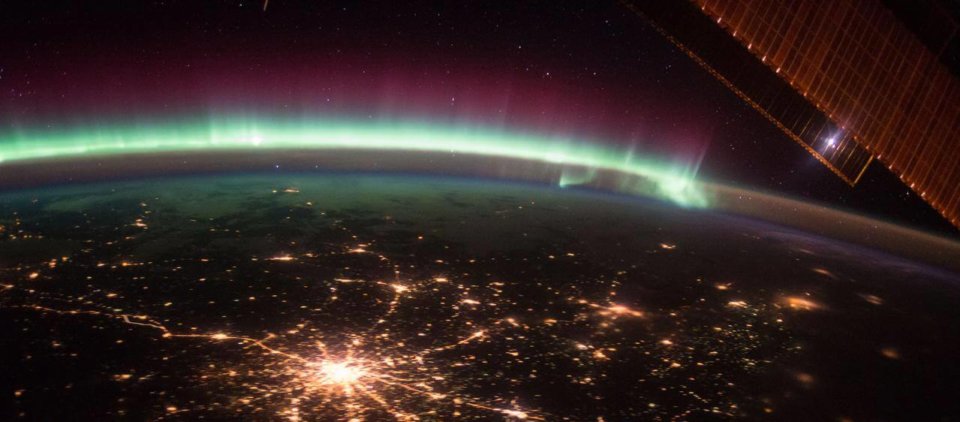This is the Saint Louis Science Center’s NIGHT SKY UPDATE for the week of Friday, April 10, 2020.
Information updated weekly or as needed.
Times given as local St. Louis time (CDT). For definitions of terminology used in the night sky update, click the highlighted text.
For now, star parties at the Saint Louis Science Center have been canceled due to recommendations from the CDC regarding COVID-19. All public telescope events are canceled until further notice. As conditions change, we will reevaluate and update this article once public observing events resume.
The Sun and Moon

The Moon as seen from the International Space Station, on July 31, 2011.
Credit: NASA
Sunrise is at 6:31 a.m. on Friday, April 10 and sunset is at 7:34 p.m. providing us with about 13 hours of daylight. Even after sunset, the light from the Sun will still dimly illuminate our sky for about 1.5 hours. This period is called twilight, which ends around 9:07 p.m. this week. For those with a sundial, solar transit or local noon occurs around 1:02 p.m. this week.
| Day | Sunrise | Sunset |
| 10 Apr | 6:31 a.m. | 7:34 p.m. |
| 11 Apr | 6:30 a.m. | 7:35 p.m. |
| 12 Apr | 6:29 a.m. | 7:36 p.m. |
| 13 Apr | 6:27 a.m. | 7:37 p.m. |
| 14 Apr | 6:26 a.m. | 7:37 p.m. |
| 15 Apr | 6:24 a.m. | 7:38 p.m. |
| 16 Apr | 6:23 a.m. | 7:39 p.m. |
| 17 Apr | 6:21 a.m. | 7:40 p.m. |
| 18 Apr | 6:20 a.m. | 7:41 p.m. |
Moonrise for Friday, April 10 occurs at 10:57 p.m. and moonset will occur at 8:25 a.m. on the following day. On Friday, April 10 the Moon will be exhibiting a waning gibbous phase with roughly 88% of the lunar disk illuminated. Last quarter moon occurs on April 14.
International Space Station (ISS)
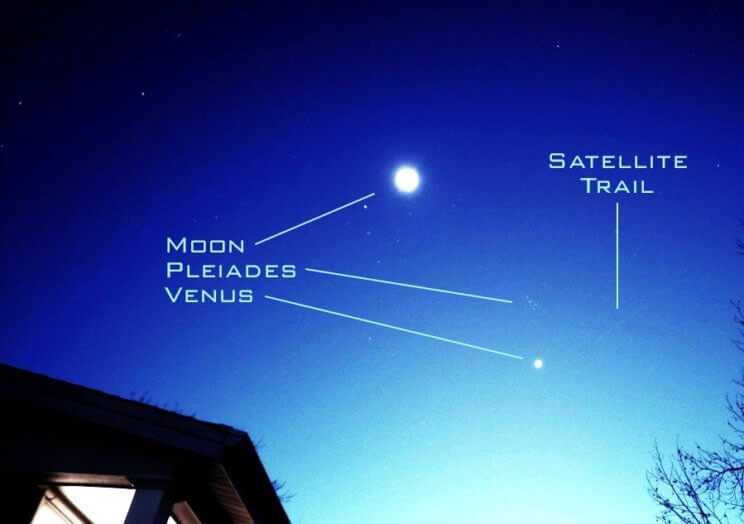
Credit: Eric Gustafson and Jordan Mogerman
There are no visible passes of ISS from St. Louis for the week of April 10. ISS will return to St. Louis skies on April 24 when it will be visible in the early morning.
This week I encourage you to see if you can locate Starlink satellites. Starlink is the constellation of satellites that is intended for communication opportunities. There is currently a conversation about these satellites and how they could negatively impact astronomical research. You can learn more about how these communication satellites could pose a risk to research in this Astronomy Magazine article.
Finding these can be tricky as most Starlink transits occur during twilight. They are bright enough that cell phone cameras can pick them up, but I do recommend using binoculars to spot them. You can find transit times from your location at Heavens-above.com. You will need to configure the website for your location.
Magnitude (Mag): The Measure of brightness for a celestial object. The lower the value is, the brighter the object will be.
Altitude (Alt): The angle of a celestial object measured upwards from the observer’s horizon.
Azimuth (Az): The direction of a celestial object, measured clockwise from an observer’s location with north being 0°, east being 90°, south being 180° and west being 270°.
For information about ISS flyovers and other visible satellites, visit www.heavens-above.com
Detailed information regarding all unmanned exploration of our universe, missions past, present, and planned, can be found at Jet Propulsion Laboratories:
The Visible Planets
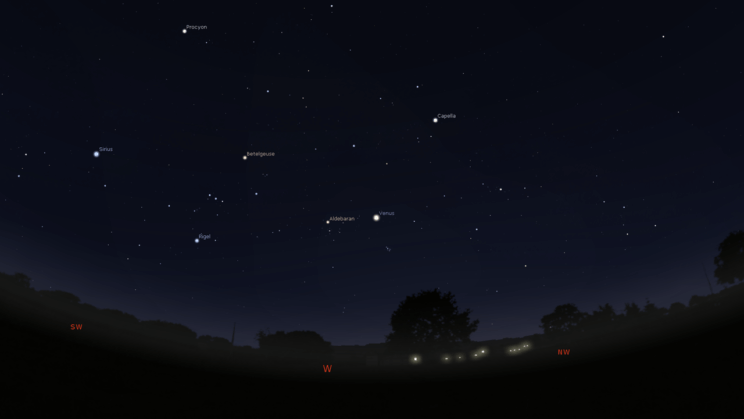
Looking West, 9:00 pm, April 10, 2020
Credit: Stellarium, EG
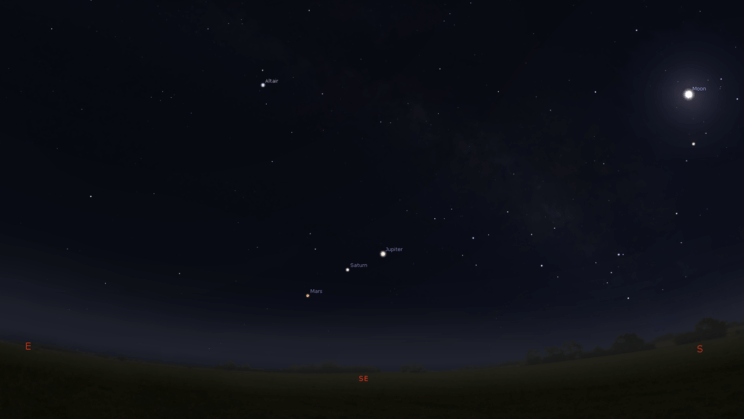
Looking Southeast, 4:30 am, April 11, 2020
Credit: Stellarium, EG
This week, four naked eye planets are visible. Venus will be visible in the west just after sunset. Mars, Jupiter and Saturn are visible in the southeast about 2 hours before sunrise. About 30 minutes before sunrise Mercury will be above the horizon but It is too low to be seen with the growing twilight glare of the Sun.
Venus
The brightest planet in the sky is visible in the western sky as the sunsets. Venus reached maximum elongation for its current apparition; because of this Venus will set earlier each night as it heads towards inferior conjunction on June 3, 2020. Venus will set around 11:25 p.m.
Mars
The red planet rises around 3:30 a.m. and will be high enough to see in the southeast by 4:30 a.m. Opposition for Mars occurs on October 13, 2020. As we head towards this date Mars will appear brighter and its surface will eventually be visible through a telescope.
Jupiter
The king of the planets is rising around 2:46 a.m. and should be visible in the southeast around 3:45 a.m. Each week you will find Jupiter rising about 30 minutes earlier than it did in the previous week.
Saturn
Saturn is rising around 3:05 a.m. Like Jupiter you will need a clear sky to the southeast to catch the ring planet around 4:00 a.m. Later this year Jupiter and Saturn will reach conjunction on December 21, 2020. You can track these planets as they appear to chase one another throughout the rest of this year.
2020 Great Conjunction
This year, the planets Jupiter and Saturn will reach conjunction. A conjunction is when two or more celestial bodies share the same right ascension. For Jupiter and Saturn, this astronomical event only occurs every 20 years. The conjunction will occur on December 21, 2020. You will find the two planets close together in the southwestern sky just after sunset on this date.
Comet C/2019 Y4 ATLAS

UPDATE for C/2019 Y4 ATLAS: April 10, 2020
Well this week does not bring us good news for Comet C/2019 Y4 ATLAS. In early April astronomers noted a distinct change in the comet’s appearance. Initially C/2019 Y4 ATLAS’s core looked more compact until April when it has changed to a more elongated fuzzy appearance. This suggests the comet has fragmented. This doesn’t mean the comet will not be the naked eye object we are hoping for, but it doesn’t look good.
If you would like to learn more about the potential breakup of the comet visit https://skyandtelescope.org/astronomy-news/comet-atlas-will-it-become-a-naked-eye-object/
Currently, the apparent magnitude of Comet C/2019 Y4 ATLAS is being reported at roughly 8.5 to 9.0 magnitude. This puts the comet within reach of backyard telescopes. It is important to remember that even at this magnitude it remains a challenging target in light polluted skies. Comet C/2019 Y4 ATLAS is currently located in the constellation Camelopardalis. This is a circumpolar constellation that is visible all night long. Due to its stars being faint, Camelopardalis is a difficult constellation to see.
Current attempts to locate the comet by this author have been unsuccessful due to light pollution. As we head towards Comet C/2019 Y4 ATLAS’s closest approach to Earth on May 23, 2020, we will continue to update the current magnitude of this comet in the night sky update. If you would like more information on Comet C/2019 Y4 ATLAS visit https://www.slsc.org/comet-atlas/
For star hoping directions to the comet use the image below. The image is for April 14; a choice made to accommodate moon phase. April 14 is last quarter Moon and as such the Moon will not rise until after 2:00 am the next morning. Keep in mind each day the comet’s position will change. If you want an up to date location, you can use the free planetarium software Stellarium.
Visit the James S. McDonnell Planetarium for more information on what’s up!
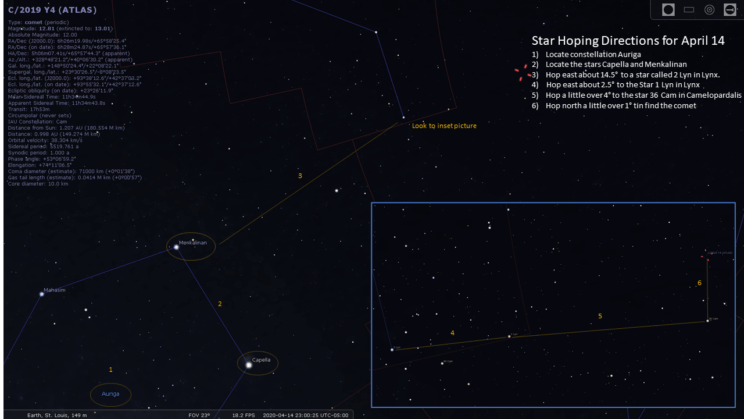
Night Sky Update: April 10-April 18, 2020






